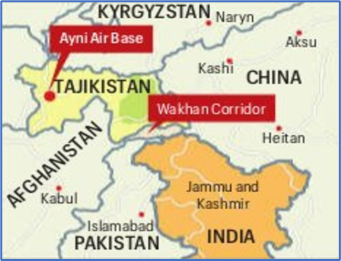Why in news?
India has withdrawn its personnel and equipment from the Ayni airbase in Tajikistan, its only full-fledged overseas military base, which it had developed and maintained for nearly two decades.
The base had provided strategic access to Central Asia and a geopolitical advantage over Pakistan, while symbolising India’s growing influence in a region shaped by Russia and China.
The withdrawal marks a significant shift in India’s regional military presence and strategic outreach in Central Asia.
What’s in Today’s Article?
- Ayni Airbase: India’s Strategic Outpost in Central Asia
- Why India Withdrew from the Ayni Airbase?
- Strategic Implications of India’s Withdrawal from Ayni Airbase
- India’s Overseas Military Presence: Limited but Strategically Expanding
Ayni Airbase: India’s Strategic Outpost in Central Asia

- The Ayni airbase in Tajikistan, located about 20 km from Afghanistan’s Wakhan Corridor near PoK and China’s Xinjiang, served as a key strategic hub for India.
- Initially used during India’s support to the Northern Alliance against the Taliban, it also facilitated the evacuation of Indian nationals from Kabul in 2021.
- Originally a Soviet-era base, Ayni was renovated by India at a cost of around $80 million under a 2002 bilateral agreement, with work led by the Border Roads Organisation (BRO).
- India upgraded it with a 3,200-metre runway, hangars, fuel depots, and air traffic control systems.
- At its peak, about 200 Indian Army and IAF personnel, along with Sukhoi-30 MKI jets, were stationed there.
- After the agreement lapsed, India began withdrawing its troops and assets in 2022, marking the end of its two-decade military presence at this vital Central Asian outpost.
Why India Withdrew from the Ayni Airbase?
- India stated that its bilateral agreement with Tajikistan for the rehabilitation and use of the Ayni airbase had ended, and the facility was formally handed back in 2022.
- The Tajik government reportedly declined to renew the lease, influenced by pressure from Russia and China, both of which have strong strategic interests in the region.
- India’s withdrawal of personnel and equipment followed quietly, with the development becoming public only recently.
Strategic Implications of India’s Withdrawal from Ayni Airbase
- The Ayni airbase was India’s only operational overseas military base, giving it a crucial strategic foothold in Central Asia.
- Located near Afghanistan’s Wakhan Corridor—bordering China’s Xinjiang and Pakistan-occupied Kashmir—the base offered India valuable security and intelligence advantages in a geopolitically sensitive region.
- India’s withdrawal marks a setback for its regional influence, as it loses a key vantage point for monitoring activities involving China and Pakistan.
- It also ends two decades of significant investment in building and maintaining this strategic outpost.
India’s Overseas Military Presence: Limited but Strategically Expanding
- With the withdrawal from Ayni airbase in Tajikistan, India currently does not operate any full-fledged overseas military base in another country.
- Strategic Infrastructure in Mauritius
- In 2024, India and Mauritius inaugurated an airstrip and jetty on Agaléga Island in the western Indian Ocean.
- These facilities extend India’s maritime reach across the Indian Ocean and enhance surveillance over waters near Africa’s east coast, countering China’s growing influence.
- The upgraded airstrip now allows operation of P-8I maritime reconnaissance aircraft, strengthening India’s naval capabilities.
- Military Cooperation with Bhutan
- India maintains a training team in Bhutan, responsible for training the Royal Bhutan Army (RBA) and the Royal Bodyguard (RBG), symbolising deep military cooperation.
- India has previously operated overseas during specific missions — from Bangladesh and Sri Lanka during the 1971 war and the IPKF deployment, respectively.
- Global Context
- While India has a modest overseas footprint, China operates a base in Djibouti and is reportedly expanding in Tajikistan.
- The United States, by contrast, maintains over 100 overseas bases across key regions like South Korea, Qatar, Germany, and Japan, underscoring the global disparity in military reach.










